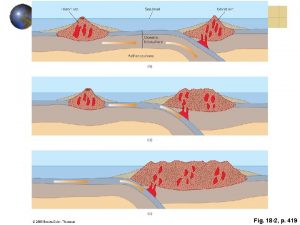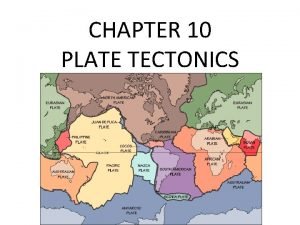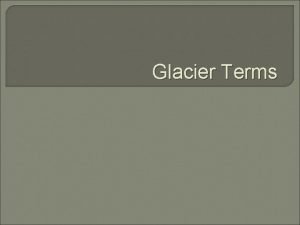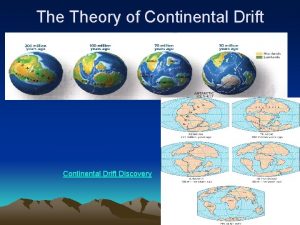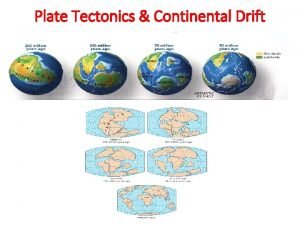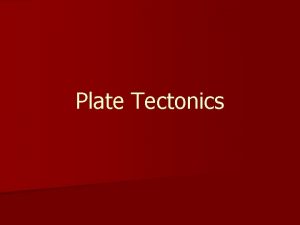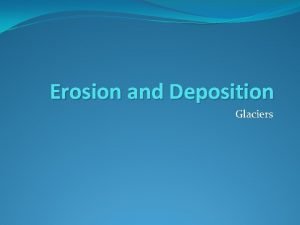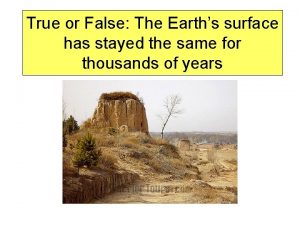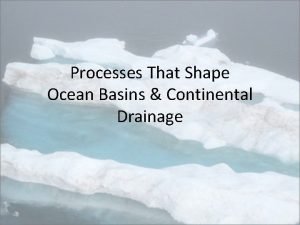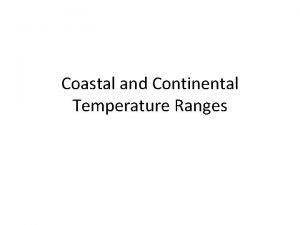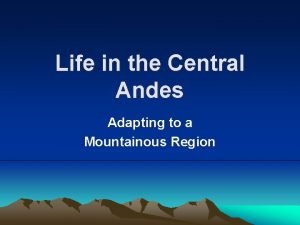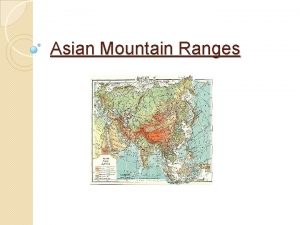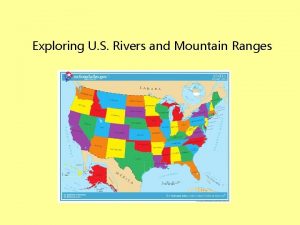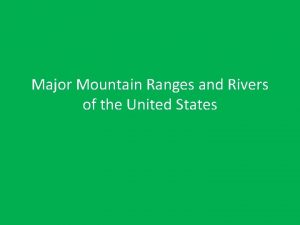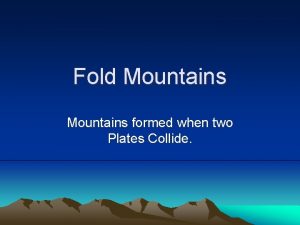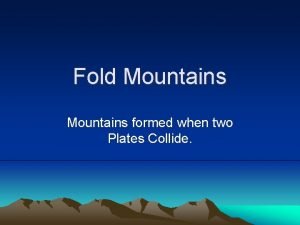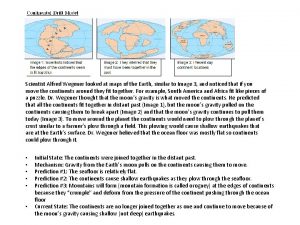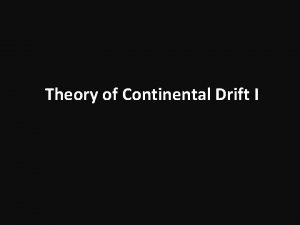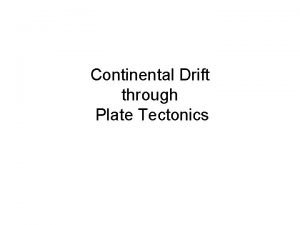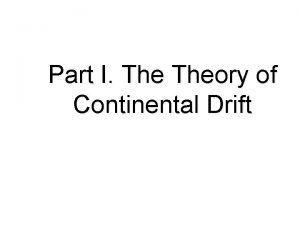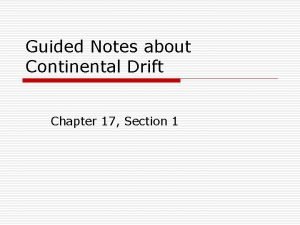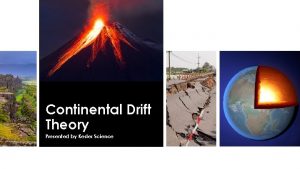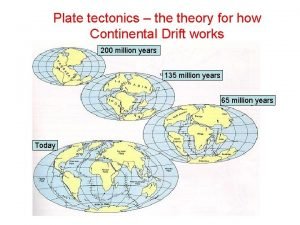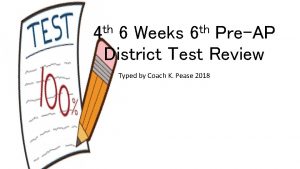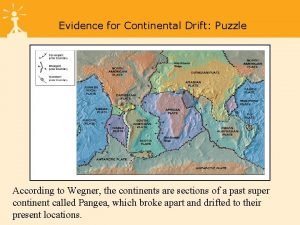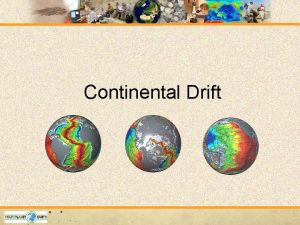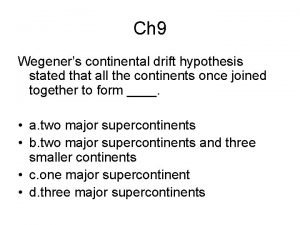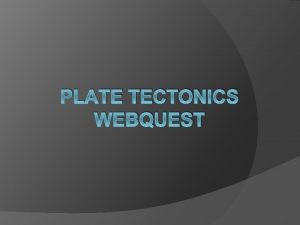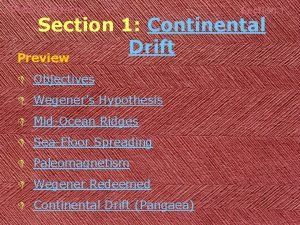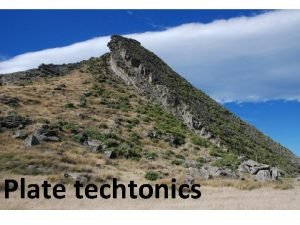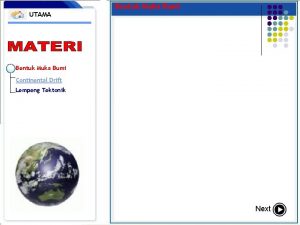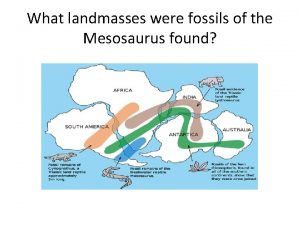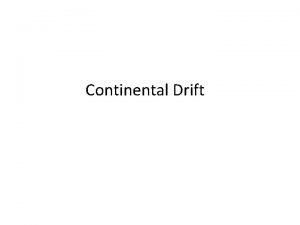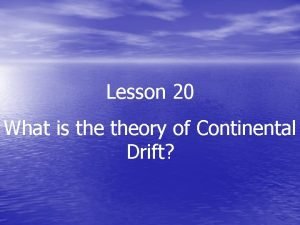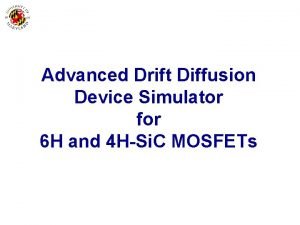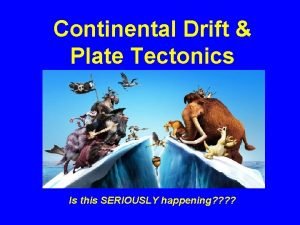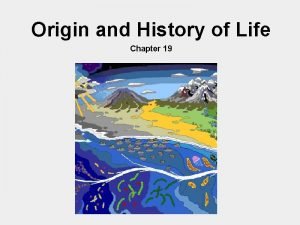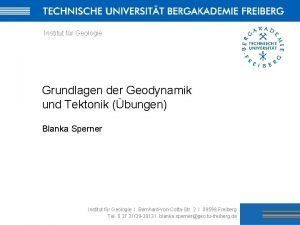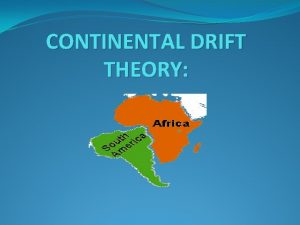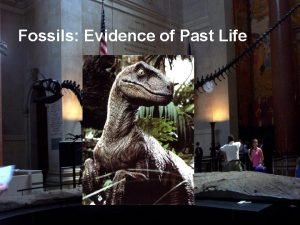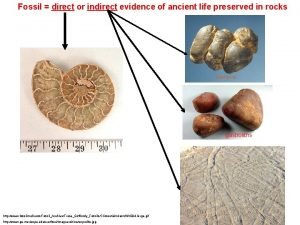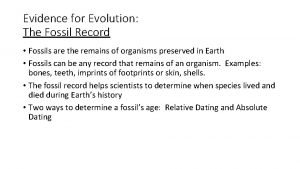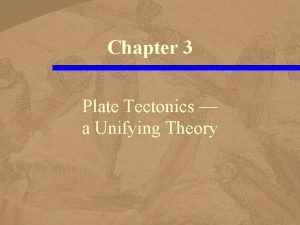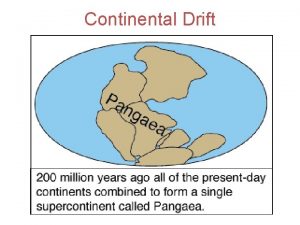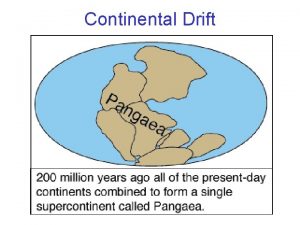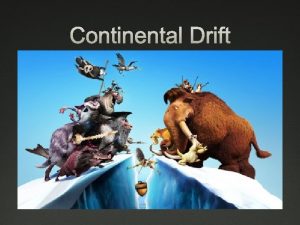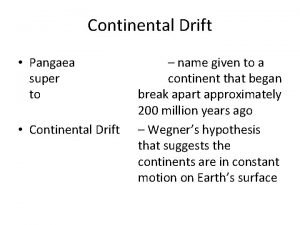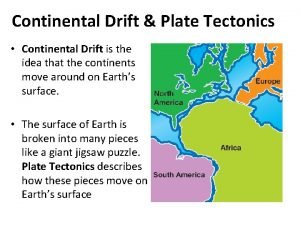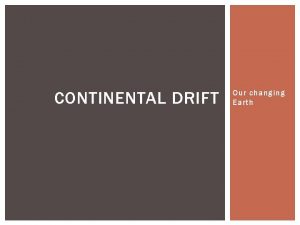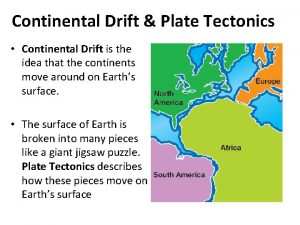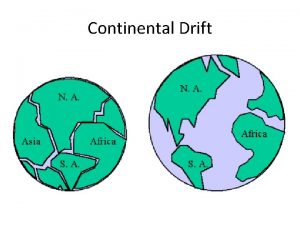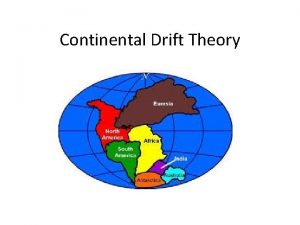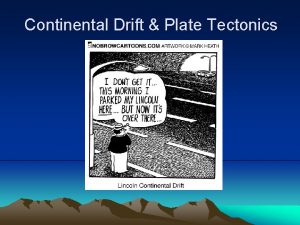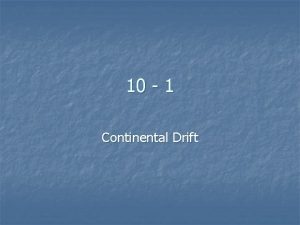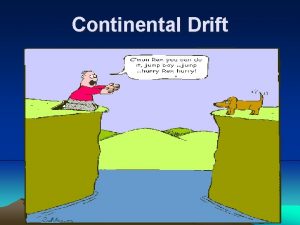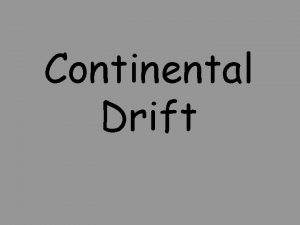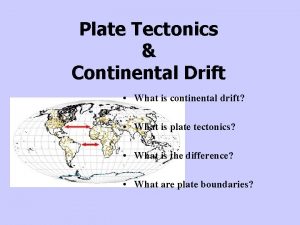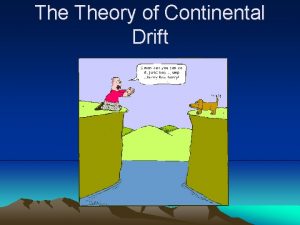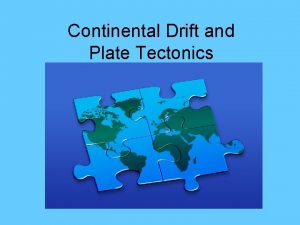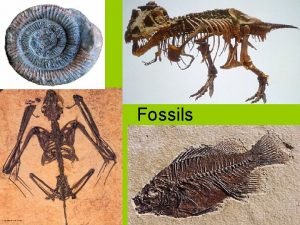Continental Drift Evidence Fossils Matching Mountain Ranges Glacier



























































- Slides: 59

Continental Drift



Evidence: Fossils

Matching Mountain Ranges

Glacier Evidence

“Uh-Oh!”: Problems with Continental Drift….

…an alternate explanation? 1928: Arthur Holmes suggested magma rises toward the crust, spreads, and sinks again. (Convection current) 1930: Wegner dies, unable to adapt Holmes’ idea to his theory.

Mantle/Crust Structure

A new hope: Sea-Floor Spreading MID-ATLANTIC RIDGE 50, 000 km. Long mountain range on the ocean floor

Evidence for Plate Tectonics q. During WWII, the U. S. in an effort to find any advantage that would help out submarines in the war effort, scientists found that the iron in the rock at the mid-ocean ridge sometimes pointed North and sometimes pointed South

How could this be? q. Basalt is iron rich and contains magnetite. Magnetite acts like a little magnet and aligns itself with the orientation of earth’s magnetic field. q. When magma solidifies, the alignment is “locked in” recording Earth’s magnetic orientation at the time of cooling.

MAGNETIC STRIPE EVIDENCE North Oriented Rocks are said to have NORMAL POLARITY South Oriented Rocks are said to have REVERSED POLARITY

The earth’s magnetic field has reversed hundreds of times


POLARITY FLIPPING AGE INCREASES AWAY FROM OPENING - RIDGE


Evidence for Plate Tectonics Ocean Drilling • The data on the ages of seafloor sediment confirmed what the seafloor spreading hypothesis predicted. • The youngest oceanic crust is at the ridge crest, and the oldest oceanic crust is at the continental margins.


Which graph best represents the geologic age of the surface bedrock on the ocean bottom?

Sea-Floor Spreading is a Divergent Plate Boundary Creates New Crust

SPLITS APART CONTINENTS TO CREATE NEW OCEANS

Spreading Center

New Ocean forming – linear Red Sea When it grows up, it will be like the Atlantic Ocean

EAST AFRICAN RIFT VALLEY – CONTINENTAL RIFT

In Afar, Ethiopia, a 40 -mile magmatic rift that opened up 1 year ago

If new crust is created at divergent boundaries, is earth getting larger? CONVERGENT BOUNDARIES – DESTROYS CRUST q Oceanic Crust converging with Continental Crust q Oceanic crust converging with Oceanic Crust q Continental Crust converging with Continental Crust

OCEAN CRUST - CONTINENTAL CRUST SUBDUCTION – TRENCH FORMS

Oceanic-Continental Convergent Boundary - SUBDUCTION DENSER OCEANIC CRUST GOES DOWN INTO MANTLE

OCEAN CRUST –OCEAN CRUST CONVERGENCE - SUBDUCTION

Oceanic Crust – Oceanic Crust Older, denser oceanic crust is SUBDUCTED (sinks below) VOLCANIC ISLAND ARC FORMED – ALEUTIAN ISLANDS TRENCH FORMS

STARTS OUT AS OCEAN-CONTINENT CONVERGENCE AND THEN AS OCEAN CRUST IS SUBDUCTED TURNS INTO CONTINENT


Continental Crust – Continental Crust Convergent Boundary NO SUBDUCTION - COLLISION ZONE

Collision of India and Asia

TRANSFORM PLATE BOUNDARIES Transform Fault Boundaries u At a transform fault boundary, plates grind past each other without creating or destroying the lithosphere. u SHALLOW EARTHQUAKES Transform faults • Most join two segments of a mid-ocean ridge. • At the time of formation, they roughly parallel the direction of plate movement.

Boundaries: Transform

SAN ANDREAS TRANSFORM FAULT

Transform Fault Boundary AT MID-OCEAN RIDGES

More Evidence for Plate Tectonics Earthquake Patterns • Scientists found a close link between deep-focus earthquakes and ocean trenches. • The absence of deep-focus earthquakes along the oceanic ridge system was shown to be consistent with the new theory.

Convergent plate (subduction) boundaries have deeper earthquakes Divergent plate boundaries and Convergent Continent-Continent collision zones have shallow earthquakes

Convergent Indian. Australian Plate and the Pacific Plate (oceanic crust to oceanic crust) are converging forming the Tonga Trench. Deep EQ’s f 07_58_pg 196

The greatest number of earthquakes in the cross section occurred at: 1. Sea level 2. Between sea level and a depth of l 00 kms. 3. at a depth between 100 – 300 kms. 4. At a depth between 300 – 600 kms.

Which cross section has arrows that best represent the relative motion of the crustal plates along the Wadati-Benioff zone beneath the Tonga Trench?

SUMMARY 3 PLATE BOUNDARIES q DIVERGING q CONVERGING (SUBDUCTION ZONE) Oceanic Crust – Continental Crust Oceanic Crust - Oceanic Crust q CONVERGING (COLLISION ZONE) Continental Crust – Continental Crust q TRANSFORM


So, what causes plates to move? • Convection currents: drag and move the lithospheric plates above the asthenosphere (three sources of heat produce the convection currents): (1) Leftover heat from earth’s formation (2) Decay of Radioactive elements (3) Plate friction

Convection Cells

Convection Currents in the mantle drag and pull the lithospheric plates above them


3 types of plate boundaries caused by convection currents CASCADES MIDATLANTIC RIDGE TRENCH

ARROWS IN THE ASTHENOSPHERE SHOW PLATE MOVEMENT DUE TO CONVECTION

The arrows shown in the asthenosphere represent the inferred slow circulation of the plastic mantle by a process called (1) insolation (3) conduction (2) convection (4) radiation

Mid-ocean ridges (rifts) normally form where tectonic plates are (1) converging (3) stationary (2) diverging (4) sliding past each other The motion of the convection currents in the mantle beneath the Atlantic Ocean appears to be mainly making this ocean basin (1) deeper (3) wider (2) shallower (4) narrower

More Evidence for Plate Tectonics Hot Spots • A hot spot is a concentration of heat in the mantle capable of producing magma, which rises to Earth’s surface; The Pacific plate moves over a hot spot, producing the Hawaiian Islands. • Hot spot evidence supports that the plates move over the Earth’s surface.

HOT SPOTS • Major regions of volcanic activity in the interior of plates away from plate boundaries. • The cause of these hot spots is thought to be plumes of magma rising up from mantle producing sites of active volcanism. • As the plate moves over a hot spot, a chain of volcanic mountains forms, like Hawaiian Islands

Hot Spot


This diagram provides evidence that the Pacific Tectonic Plate is moving toward the (1) south (3) southwest (2) east (4) northwest
 Glacial evidence of pangea
Glacial evidence of pangea Chapter 10 plate tectonics
Chapter 10 plate tectonics Glacier terms
Glacier terms Continental drift
Continental drift Continental drift
Continental drift Evidence of continental drift
Evidence of continental drift Is a valley
Is a valley How ice causes erosion
How ice causes erosion Continental glacier
Continental glacier Coastal and continental temperature ranges
Coastal and continental temperature ranges Major mountain ranges world map
Major mountain ranges world map Ural mountains
Ural mountains Mountain ranges in south america map
Mountain ranges in south america map Mississippi river length
Mississippi river length Indiana major mountain ranges
Indiana major mountain ranges Fold mountains outside ireland
Fold mountains outside ireland Mountain plates
Mountain plates Compare continental drift and plate tectonics
Compare continental drift and plate tectonics Proof of continental drift theory
Proof of continental drift theory Continental drift warm up
Continental drift warm up Fossil correlation continental drift
Fossil correlation continental drift Continental drift theory slideshare
Continental drift theory slideshare Continental drift notes
Continental drift notes Kesler science plate boundaries
Kesler science plate boundaries Continental drift
Continental drift Continetial drift
Continetial drift Proof of continental drift theory
Proof of continental drift theory Mid oceanic ridge
Mid oceanic ridge Continental drift puzzle
Continental drift puzzle Plate tectonics vs continental drift
Plate tectonics vs continental drift Similar fossils found on different continents
Similar fossils found on different continents What type of
What type of Webquest plate tectonics
Webquest plate tectonics First related the symmetrical magnetic patterns
First related the symmetrical magnetic patterns Paleoglaciation continental drift
Paleoglaciation continental drift 7 lempeng bumi utama
7 lempeng bumi utama Continental drift
Continental drift Continental drift theory
Continental drift theory Continental drift
Continental drift Continental drift theory
Continental drift theory Continental drift
Continental drift Continental drift simulator
Continental drift simulator Plate tectonic theory vs continental drift
Plate tectonic theory vs continental drift Continental drift
Continental drift Continental drift
Continental drift Continental drift adalah
Continental drift adalah The continental drift theory
The continental drift theory Site:slidetodoc.com
Site:slidetodoc.com Convergent plate boundary
Convergent plate boundary Fossils evidence of past life
Fossils evidence of past life Indirect fossil
Indirect fossil How amber is formed
How amber is formed Fossil and mountain chain evidence
Fossil and mountain chain evidence Jobs vancouver
Jobs vancouver Class evidence can have probative value
Class evidence can have probative value Primary evidence vs secondary evidence
Primary evidence vs secondary evidence A pair of latex gloves was found at a crime scene
A pair of latex gloves was found at a crime scene Fiber evidence can have probative value.
Fiber evidence can have probative value. Primary evidence vs secondary evidence
Primary evidence vs secondary evidence The absence of evidence is not evidence of absence meaning
The absence of evidence is not evidence of absence meaning
